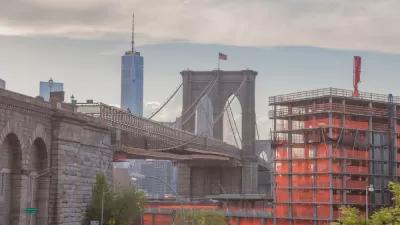New analysis from Richard Florida and the Martin Prosperity Institute maps segregation by employment type, finding the darker effects of the creative class.

Emily Badger shares insight into new analysis by Richard Florida and the Martin Prosperity Institute that uses American Community Survey data to map the types of occupations held by residents of American cities. The analysis produces findings that expand beyond traditional understandings of segregation as measured merely by income level, according to Badger:
Their results point to a different picture of socioeconomic segregation in American cities — one divided more explicitly by the nature and type of work we do, rather than how much money we make doing it — than we're used to discussing.
The analysis separates workers into three classes, derived from Florida's research: "creative class," "service class," and "working class." Among the observations Badger provides in her take is that the 12 surveyed cities have retained "strikingly few working-class strongholds."
The study was released today, timed for the second annual CityLab conference in Los Angeles. Florida has also provided his own take on the study.
FULL STORY: Mapped: How the ‘creative class’ is dividing U.S. cities

Planetizen Federal Action Tracker
A weekly monitor of how Trump’s orders and actions are impacting planners and planning in America.

Maui's Vacation Rental Debate Turns Ugly
Verbal attacks, misinformation campaigns and fistfights plague a high-stakes debate to convert thousands of vacation rentals into long-term housing.

Restaurant Patios Were a Pandemic Win — Why Were They so Hard to Keep?
Social distancing requirements and changes in travel patterns prompted cities to pilot new uses for street and sidewalk space. Then it got complicated.

In California Battle of Housing vs. Environment, Housing Just Won
A new state law significantly limits the power of CEQA, an environmental review law that served as a powerful tool for blocking new development.

Boulder Eliminates Parking Minimums Citywide
Officials estimate the cost of building a single underground parking space at up to $100,000.

Orange County, Florida Adopts Largest US “Sprawl Repair” Code
The ‘Orange Code’ seeks to rectify decades of sprawl-inducing, car-oriented development.
Urban Design for Planners 1: Software Tools
This six-course series explores essential urban design concepts using open source software and equips planners with the tools they need to participate fully in the urban design process.
Planning for Universal Design
Learn the tools for implementing Universal Design in planning regulations.
Heyer Gruel & Associates PA
JM Goldson LLC
Custer County Colorado
City of Camden Redevelopment Agency
City of Astoria
Transportation Research & Education Center (TREC) at Portland State University
Jefferson Parish Government
Camden Redevelopment Agency
City of Claremont





























